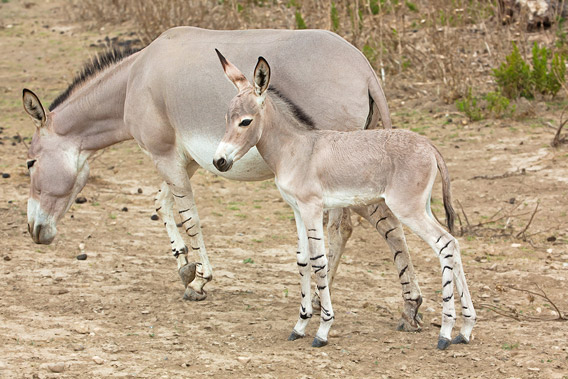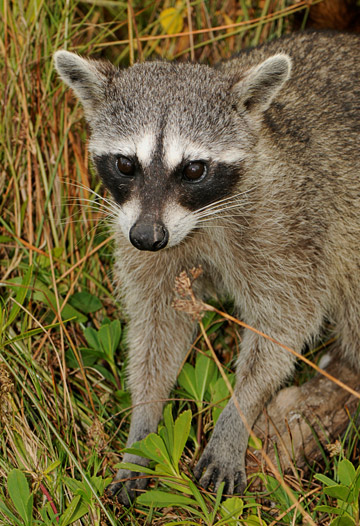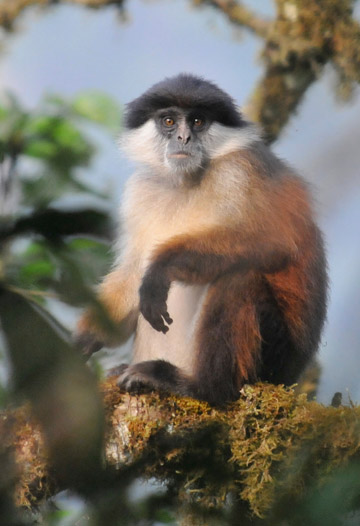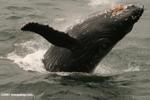
Somali wild ass and mother in nature. The African wild ass could be a conservation flagship species according to a new paper. Photo by: Bigstock.
A cursory look at big conservation NGOs might convince the public that the only species in peril are tigers, elephants, and pandas when nothing could be further from the truth. So, why do conservation groups roll out the same flagship species over-and-over again? Simple: it is believed these species bring in donations. A new paper in Conservation Letters examines the success of using flagship species in raising money for larger conservation needs, while also pointing out that conservation groups may be overlooking an important fundraising source: “Cinderella animals.”
Too much focus on “flagship species”?
Flagship species are animals used by conservation groups to raise funds; these species are almost always mammals, large, and appealing to the general public, often defined as ‘cute.’ This trend has long faced criticism: some researchers argue that in an age of mass extinction focusing on a few mammals trivializes the scale of the problem and leaves the bulk of the world’s threatened species without targeted protection.
But conservation groups counter that protecting flagship species brings benefits to the entire ecosystem, for example, protecting the tiger means conserving the remaining forests of Asia and its biodiversity. In addition, funds raised by flagship species are sometimes dispersed to programs beyond single-species conservation.
 The pygmy raccoon could make a good conservation icon according to a new paper. The species is only found on the island of Cozumel. Photo by: Scott Camazine. |
“Flagship species campaigns remain a key fundraising tool for international conservation NGOs because they strongly resonate with
the general public,” write the authors of the study in Conservation Letters.
The researchers examined fundraising efforts by 59 international conservation groups working in developing countries and found that in total 80 flagship species were utilized. Tigers and elephants (both Asian and African) were the most popular.
Following the money, the researchers found that 60 percent of the campaigns raised money directly for the flagship species. Over a third of campaigns raised money for the NGO’s general programs, while only 2 percent of the campaigns raised funds for a general conservation issue that would likely benefit many species.
But perhaps most disconcerting was that conservation NGOs took little note of species’ threat level.
“The IUCN Red List status of these threatened species was not important [in conservation groups’ flagship species], so that Critically Endangered species were no more likely to be selected as flagships than Vulnerable species,” the researchers write.
While the researchers admit that their are numerous problems with the flagship strategy, they also note that it is effective in raising funds and attracting new supporters.
Cinderella species
According to the paper, one simple solution to the flagship species problem is to expand the number of such icons. This would help support conservation in new regions as well as protect hugely imperiled animals, the paper argues.
 Pennant’s red colobus is a “Cinderella species.” Photo by: Richard Bergl. |
To this end, the researchers surveyed the world’s 1,098 mammals for those that would fit general flagship criteria: large-bodied and forward facing eyes (a sign of appeal or ‘cuteness’). The researchers found 183 species that have not been utilized by conservation groups, over twice as many mammals as conservation groups currently highlight according to the study.
“The approach of NGOs remains overly conservative, so that only a few well-known species receive the bulk of the money raised. In response, we have shown that there are a number of currently neglected mammal species that are both highly threatened and potentially appealing to the public,” lead author Robert Smith with the Durrell Institute of COnservation and Ecology (DICE) at the UNiversity of Kent said in a press release. They call these “cinderella species” after the fairy-tale of the long-neglected commoner who overnight becomes a princess.
From these 183 Cinderellas, the study chose five of the best representatives, each of them listed as Critically Endangered, to highlight the potential of broadening the flagship strategy to more species: the Talaud bear cuscus (Ailurops melanotis) from Indonesia, Pennant’s red colobus (Procolobus pennantii) of West Africa, the tamaraw or Mindoro dwarf buffalo (Bubalus mindorensis) from the Philippines, the African wild ass (Equus africanus) from the Horn of Africa, and the pygmy raccoon (Procyon pygmaeus) from Mexico.
“Any organization with a biodiversity-based mission has a duty to broaden the conservation benefits of their fundraising. […] This is why we need to identify additional species for use in these traditional international campaigns,” the researchers write.
CITATION: Robert J. Smith, Diogo Verissimo, Nicholas J.B. Isaac, Kate E. Jones. Identifying Cinderella species: uncovering mammals with
conservation flagship appeal. Conservation Letters. 2012.
Related articles
Turkey’s rich biodiversity at risk

(03/28/2012) Turkey: the splendor of the Hagia Sophia, the ruins of Ephesus, and the bizarre caves of the Cappadocia. For foreign travelers, Turkey is a nation of cultural, religious, and historic wonders: a place where cultures have met, clashed, and co-created. However, Turkey has another wealth that is far less known: biodiversity. Of the globe’s 34 biodiversity hotspots, Turkey is almost entirely covered by three: the Caucasus, the Irano-Anatolian, and the Mediterranean. Despite its wild wealth, conservation is not a priority in Turkey and recent papers in Science and Biological Conservation warn that the current development plans in the country, which rarely take the environment into account, are imperiling its species and ecosystems.
Over 5,000 vital biodiversity sites remain unprotected
(03/22/2012) A recent study has found that half of the world’s Important Bird Areas (IBAs) and Alliance for Zero Extinction (AZE) sites remain unprotected, leaving many endangered species, some on the verge of extinction, gravely vulnerable to habitat loss. Published in the open access journal PLoS ONE, the study urges governments to focus on expanding protected areas to cover the species that need it most.
Unanimous agreement among scientists: Earth to suffer major loss in species

(11/09/2011) The thylacine, the dodo, the great auk, the passenger pigeon, the golden toad: these species have become symbols of extinction. But they are only the tip of the recent extinction crisis, and according to a survey of 583 conservation scientists, they are only the beginning. In a new survey in Conservation Biology, 99.5 percent of conservation scientists said a serious loss in biodiversity was either ‘likely’, ‘very likely’, or ‘virtually certain’. The prediction of a significant loss of species is not surprising—scientists have been warning for decades that if global society continues with business as usual the world will suffer from mass extinction—what is perhaps surprising is the practically unanimous expectation that a global biodiversity decline will occur.
Humanity knows less than 15 percent of the world’s species

(08/23/2011) Scientists have named, cataloged, and described less than 2 million species in the past two and a half centuries, yet, according to an new innovative analysis, we are no-where near even a basic understanding of the diversity of life on this small blue planet. The study in PLoS Biology, which is likely to be controversial, predicts that there are 8.7 million species in the world, though the number could be as low as 7.4 or as high as 10 million. The research implies that about 86 percent of the world’s species have still yet to be described.
Cameratraps take global snapshot of declining tropical mammals

(08/17/2011) A groundbreaking cameratrap study has mapped the abundance, or lack thereof, of tropical mammal populations across seven countries in some of the world’s most important rainforests. Undertaken by The Tropical Ecology Assessment and Monitoring Network (TEAM), the study found that habitat loss was having a critical impact on mammals. The study, which documented 105 mammals (nearly 2 percent of the world’s known mammals) on three continents, also confirmed that mammals fared far better—both in diversity and abundance—in areas with continuous forest versus areas that had been degraded.
The glass is half-full: conservation has made a difference

(08/11/2011) Don’t despair: that’s the message of a new paper in Trends in Ecology and Evolution, which argues that decades of conservation actions at multiple scales have had a positive impact for many of the world’s endangered species. While such actions have not yet turned back the tide of the current mass extinction crisis, they have achieved notable successes which often get lost in the gloom-and-doom news stories on biodiversity declines. According to the paper, conservation actions take place on three scales. Microscale conservation focuses on a single species or ecosystem; mesoscale means conservation cooperation between a number of countries, such as efforts to curb the illegal wildlife trade or protect wide-ranging species; and finally macroscale means global organizations or campaigns, such as those that pressure multinational corporations to become more biodiversity-friendly.